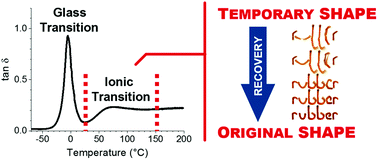The shape-memory effect in ionic elastomers: fixation through ionic interactions†
Abstract
Shape-memory elastomers based on a commercial rubber cross-linked by both ionic and covalent bonds have been developed. The elastomeric matrix was a carboxylated nitrile rubber (XNBR) vulcanized with magnesium oxide (MgO) providing ionic interactions that form hierarchical structures. The so-named ionic transition is used as the unique thermal transition responsible for the shape-memory effect (SME) in these elastomers. These ionic interactions fix the temporary shape due to their behavior as dynamic cross-links with temperature changes. Covalent cross-links were incorporated with the addition of different proportions of dicumyl peroxide (DCP) to the ionic elastomer to establish and recover the permanent shape. In this article, the SME was modulated by modifying the degree of covalent cross-linking, while keeping the ionic contribution constant. In addition, different programming parameters, such as deformation temperature, heating/cooling rate, loading/unloading rate and percentage of tensile strain, were evaluated for their effects on shape-memory behavior.



 Please wait while we load your content...
Please wait while we load your content...